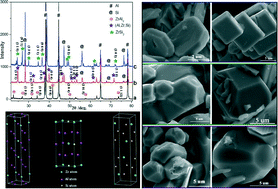Morphological evolutions and growth patterns of Zr-containing phases in aluminum alloys
Abstract
Three-dimensional morphologies of Zr-containing phases in Al–(Si–)Zr alloys were studied in detail using field emission scanning electron microscopy. Combining the analysis of crystallographic features with atomic arrangement in the crystal lattices and first-principles quantum mechanics calculations, the growth mechanisms of Zr-containing phases were discussed. As reported in previous work, the increase of Si content in Al–(Si–)Zr alloys leads to the continuous composition evolution and a structure transformation from ZrAl3 to (Al,Zr,Si) and ZrSi2. The perfect morphology of ZrAl3 is compressed cubic, whose lateral surfaces are composed of four groups of symmetric planes. (Al,Zr,Si) has similar crystal shape to ZrAl3, while the cube is much thicker and the growth process is changed. Further high Si content results in the formation of the ZrSi2 phase, presenting 18-polyhedral morphology, whose upper and lower surfaces are also covered by (0 0 1) planes, while its lateral surface is composed of eight groups of symmetric {1 1 0} and {1 1 1} planes. Similar growth mechanisms of Ti-containing phases in Al–(Si–)Ti alloys have also been found.


 Please wait while we load your content...
Please wait while we load your content...